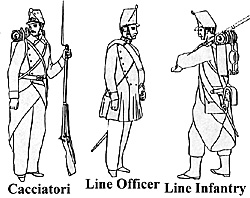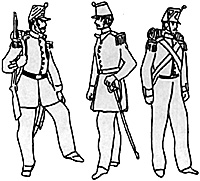(Editor's Note: a significant proportion of this article is drawn from Red Shirts, Garibaldi's Campaign in Southern Italy - 1860 by Luigi Casale. The book was printed by Ulster Imports, a company no longer extant; we feel however, that the information is so significant that it should not remain lost to the new generation of 19th century war-gamer.)
Uniform Guide
General Information: Only those units present at the Volturno will be covered here. Unless otherwise noted, all shakos have a black cover. Field dress consists of a gray-bluish greatcoat, with aquamarine trousers a shade darker than the coat. Gaiters are generally worn, of the same colour as the trousers. Cross belts are generally white.
Troops of the Line
Infantry:
Fusilier companies wore a deep blue pom-pom with a white centre and yellow company number on their shako, with the regimental number, also yellow, painted on the shako front. The issue greatcoat had a thre-pointed collar patch in the brigade colour; the 6th Infantry having crimson, the 8th infantry having light blue, and the 9th infantry having orange.
Grenadiers were issued red-fringed epaulettes; cacciatori had green ones. Fusilier companies had only shoulder straps in the greatcoat colour. And the 9th infantry had brass buttons, while the 6th and the 8th had tin. Shoes were black. Cartridge boxes had a white cloth cover. The rifled musket had a brown stock, brass fittings, and a white sling. Grenadiers and Cacciatori carried short swords, while the fusiliers had only the bayonet. Scabbards were black with brass fittings.
Drummers were uniformed as the rank and file, with the addition of some lace around the collar. Drums had brass cases, with the rims painted with broad white and brigade diagonal colour stripes. Cords were white.
Officers were uniformed as those of the Royal Guard, with a possible propensity for wearing red or white full dress trousers in the field, instead of aquamarine. Buttons were either gold or silver, depending on the colour assigned to the regiment.
Cacciatori Battalions:
 Shako pom-pom was black, above a yellow cornet with the battalion number in the centre. The greatcoat collar patches were yellow, except for the 13th (Swiss) Battalion which had black patches. Epaulettes were deep green, and there is contradictory evidence as to whether they were worn in the field. Trousers and gaiters were supposed to be aquamarine, but there are some pictures showing white trousers being worn in the field.
Shako pom-pom was black, above a yellow cornet with the battalion number in the centre. The greatcoat collar patches were yellow, except for the 13th (Swiss) Battalion which had black patches. Epaulettes were deep green, and there is contradictory evidence as to whether they were worn in the field. Trousers and gaiters were supposed to be aquamarine, but there are some pictures showing white trousers being worn in the field.
The 8th Battalion wore black belting, instead of the usual white. All waistbelt plates and buckles were brass. The rifled carbine had a light brown stock and brass fittings.
Officers wore either shakos or a deep green kepi with gold rank distinctions, yellow piping, and small pom-poms. Buttons were brass. Trousers were to be aquamarine, but there are pictures showing the use of both white and grey. Belts were black.
Foreign Carabineer Battalions:
(NB. Casali reports that there is a scarcity of information on these units and their uniforms. What info there is usually pertains to specific units.)
The 1st and 2nd battalions probably wore greatcoats of standard colour and pattern, possibly with black but more probably with green collar patches. A grey-blue kepi was sometimes worn in place of the shako. Trousers were grey-blue with a green stripe.
The 3rd battalion used black as their distinctive colour. Their kepis were deep green with a black band and piping. Trousers were as for the 1st and 2nd battalions, with a black stripe.
Gaiters and equipment would be as for the Cacciatori. Armament consisted of a rifled carbine and a sabre bayonet in a black scabbard.
Artillerists
 The foot artillery wore a double red pom-pom atop the shako, which had a yellow regimental number painted on the front. The single-breasted coat was deep blue with red piping, self coloured shoulder straps, collar and cuff patches. The cuffs themselves were squared and red, as were the turnbacks. A bayonet and a short sword was worn, belting was white, with black cartridge boxes and black scabbards. Trousers were deep blue for winter and white for summer, but may have been aquamarine for the field.
The foot artillery wore a double red pom-pom atop the shako, which had a yellow regimental number painted on the front. The single-breasted coat was deep blue with red piping, self coloured shoulder straps, collar and cuff patches. The cuffs themselves were squared and red, as were the turnbacks. A bayonet and a short sword was worn, belting was white, with black cartridge boxes and black scabbards. Trousers were deep blue for winter and white for summer, but may have been aquamarine for the field.
Officers wore a deep blue double-breasted frock coat, with gold buttons and fringed epaulettes, blue collar and cuffs. Headgear was a deep blue kepi with a black peak and gold rank distinctions.
The horse artillery wore the same uniform as the foot artillery, with the following exceptions: the coat was double breasted, with red fringed epaulettes, pointed cuffs, and turnbacks. Ttousers were deep blue with a red double stripe. The sabre scabbard was steel. Shabraques were deep blue with a broad red edge and grenade in the corners. This was generally covered with a black fur.
Gun carriages were painted a medium gray-green.
CAVALRY
(As only the Lancers took part in the action at the Volturno, only their uniforms will be detailed here.)
Lancers
 The helmet was the typical Uhlan-style "tscapka", black with red pom-poms and brass piping on the peak's edge. The kurtka had a deep blue plastron piped in red and a deep plue collar with three-pointed red patches. Trousers were white in the summer or madder-red with a double deep blue stripe in the winter. All belts were white with a brass plate and buckles whille the cartridge box was black.
The helmet was the typical Uhlan-style "tscapka", black with red pom-poms and brass piping on the peak's edge. The kurtka had a deep blue plastron piped in red and a deep plue collar with three-pointed red patches. Trousers were white in the summer or madder-red with a double deep blue stripe in the winter. All belts were white with a brass plate and buckles whille the cartridge box was black.
The lance had a brown stave with a red-over-white pennant. A brass hilted curved sabre with a white sword know and two pistols completed their armament. Shabraques were madder red with a deep blue edge piped red; white, crossed lances were in the pointed corners.
Trumpeters wore a similar uniform, but with a white collar and white lace on the cuffs. Additionally, the sleeves had ten white chevrons, placed point up. Epaulettes were red straps with white crescents and fringe. Trumpets were brass with white cords.
-Finis-
Back to Clash of Empires No. 3/4 Table of Contents
Back to Clash of Empires List of Issues
Back to Master Magazine List
© Copyright 1998 by Keith Frye
This article appears in MagWeb (Magazine Web) on the Internet World Wide Web.
Other military history articles and gaming articles are available at http://www.magweb.com